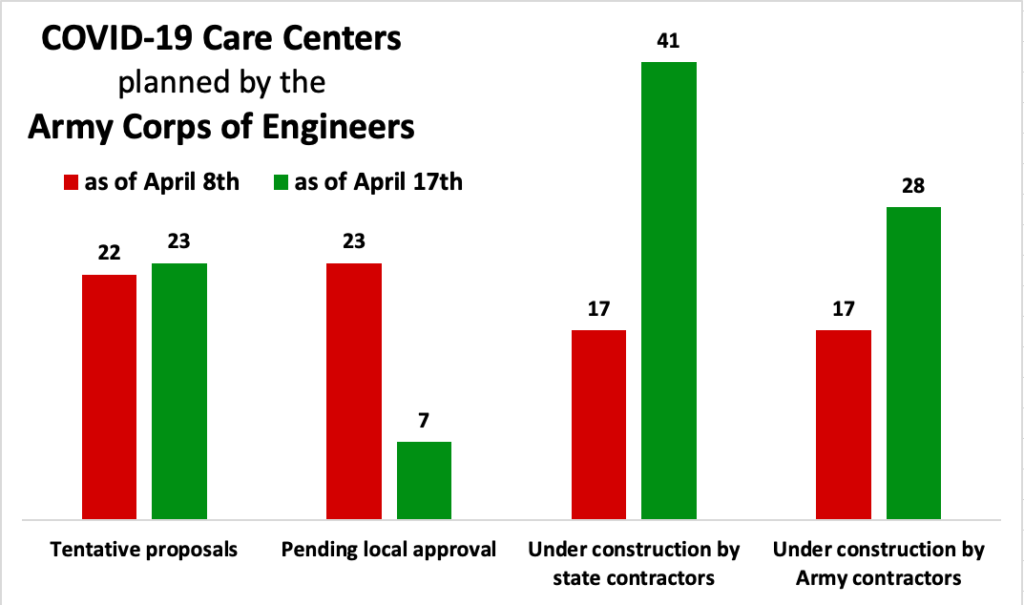COVID-19: Army Corps’ Ad Hoc Hospital Construction Soars

Breaking Defense graphic from Army Corps of Engineers data
WASHINGTON: The commander of the Army Corps of Engineers had major progress to report today since he last briefed the press nine days ago. Since April 8th, Lt. Gen. Todd Semonite reported:
- The number of ad hoc care centers under construction by the Corps has jumped from 17 to 28, with a projected capacity of nearly 16,000 patients. All but one of those sites will be able to handle contagious COVID-19 cases – a stark reversal of the military’s original plan to take only non-COVID patients. FEMA bears 75 percent of the cost, the state or city 25 percent.
- The number of centers being built by state and local authorities using Corps-provided plans has more than doubled, from 17 to 41, with a projected capacity of over 17,000 beds.
- Meanwhile, the number of site plans completed but awaiting local approval to proceed – a hold-up Semonite was anxious about last week – has plummeted from 23 to seven, with just 883 beds among them. Some of those proposals have moved into construction while others were deemed unnecessary.
These figures don’t include facilities that states and cities are constructing entirely on their own, just sites the Corps found, surveyed, and drew up construction plans for. They also don’t reflect the contracts the Corps is working on right now – including one for Washington, DC.
The Corps was already building a very modest COVID-19 capability, just 37 beds, at the United Medical Center in southeast DC. But “there was a decision made yesterday on the DC Convention Center,” Semonite said. “We’re getting ready to start building there. I don’t have the contract data yet, my guys are still working through that, [but] it could be anywhere from 500 to 1,500 [beds],” he said.
The chart below lists the individual sites the Corps is already building that are capable of handling COVID-19 patients, how many beds they’ll have when complete, and progress on their construction to date:
Breaking Defense graphic from Army Corps of Engineers data
Some crucial information that’s still missing: how many of these facilities have actually opened for patients, and how many beds are available. When I asked Semonite (over the phone), he said his staff should be able to provide those numbers, and we’ll report them when we have them.
Now, the Army Corps of Engineers does not provide medical personnel or supplies for these sites. They build them — in itself a daunting task. Contractors at some locations are working 24 hours a day. Even sites that already have individual rooms with their own bathrooms, sinks, and beds, like hotels and some college dormitories, need run pipes installed for oxygen tanks and adjustments made to the AC to contain contaminated air. The vast open spaces of sports arenas and convention centers need everything from interior partitions for rooms to showers (they have enough toilets already, Semonite said).
And the Army Corps of Engineers is doing all this through contractors, with most of its employees – almost all of them civil servants, not soldiers – working from home. The Corps’ capacity for telework connections has leapt from 5,000 to 40,000 in the last month. The plans the Corps is now drawing up are mostly being created on-line, not in face to face planning sessions.
Lt. Gen. Semonite and his aides, however, are flying from city to city in a government plane to check out sites. They’re also being checked out constantly themselves. There’s a microbiologist with a no-touch thermometer traveling with the general, he said, and “I get my temperature taken [about] a hundred times a day.”
Protecting the health of the Corps’ workforce – including himself – is a top priority, Semonite said. But that won’t stop them from doing their job.
“I can’t think of a more noble calling right now for an engineer,” the general said.